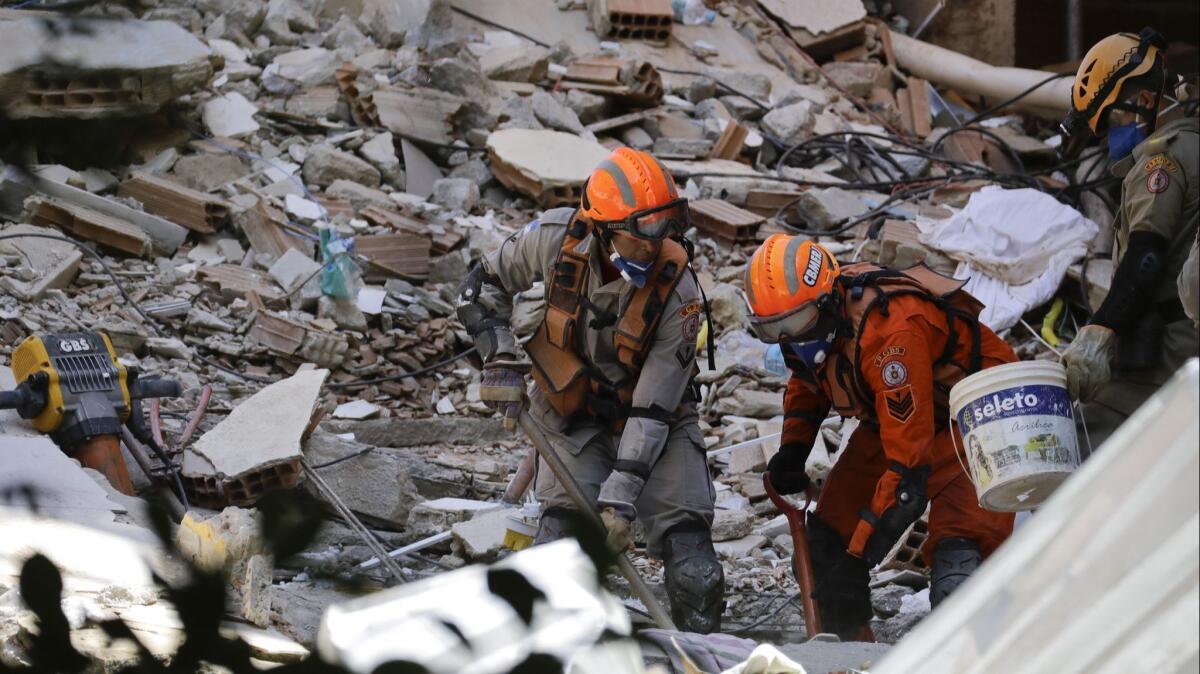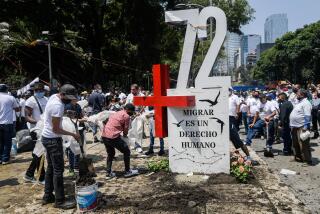Rio buildings collapse in working-class neighborhoods where militias hold sway

- Share via
Reporting from Rio de Janeiro — The last of 24 bodies was pulled from the wreckage in the early hours of Easter morning.
Firefighters and soldiers had searched for more than 200 hours through what was left of the two Muzema neighborhood apartment buildings that collapsed on April 12, the end of a work week that saw Rio de Janeiro pummeled by torrential storms and severe flooding.
As the number of bodies continued to mount, so did the questions. Why did the buildings, home to blue-collar families thrilled to finally own their own apartments, come down? Could something have been done to prevent the tragedy? And did the faceless paramilitary groups which have largely taken armed control of Rio’s working-class west end communities, known as favelas, bear responsibility?
Since first cropping up in the late 1990s as an antidote to drug gang violence and government corruption, the shadowy militias, said to be run mainly by current and former police officers, soldiers and prison guards, have charged residents and businesses on the periphery of the city for pirated TV and Internet connections, as well as water, gas and electricity — all under the guise of providing “security services.”
Some are also believed to have a hold on housing in the communities where they operate, clearing land through evictions for construction companies they control, experts say. They also are thought to collect payments through agents who sell or rent out units in newly erected buildings, many of which have not been properly inspected because of threats made to authorities.
Arrest warrants have been issued for three men suspected of taking part in the construction and sale of the apartments in the buildings that collapsed last month. The organized crime unit of Rio’s civil police is investigating their possible involvement with the militia operating in Muzema, according to the municipal government.
Rio’s municipal government knew the buildings were unsafe long before they crumbled. The lot where they were located, part of a condominium complex called Figueiras do Itanhangá, is on a designated Environmentally Protected Area and was first embargoed by the Municipal Secretariat of Urbanism (SMU) in October 2005. At the time, it was noted that the complex did not have proper drainage, sewage and water systems, and that the area was unpaved and without curbs.
Before the collapse, the SMU had issued 17 infraction notices for irregular construction and the Municipal Civil Defense condemned the buildings on Feb. 8 because of a risk of landslides and falling rocks caused by improper excavation. According to the city’s Geotechnical Institute Foundation Slip Susceptibility Map, the area is classified as mid-high risk for landslides and mudslides.
Since the tragedy, Rio’s mayor Marcelo Crivella has announced that another 16 buildings in Muzema will be demolished because of the risk they’ll collapse. The action, he said, follows an edict to identify buildings with structural problems.
“Since 2017, when I signed this decree, we have run the entire city of Rio de Janeiro, handing out notifications to several construction sites,” he said. “There are embargoes, there are notifications of demolitions. Many of them were suspended by court decisions. Now, after this tragic accident that we had with the victims of Muzema, the justice system has ordered the demolition of several buildings.”
The first of the 16 buildings came down on April 24, and work has begun on another that neighbored the two that collapsed.
The demolition process is slow. Because the buildings are close to others that still house tenants, explosives can’t be used. Instead, technicians from the Municipal Secretariat of Conservation are manually disassembling the imperiled building.
In an unusual show of authority, police are providing security as the crews work, with military officers stationed at the community’s access roads and civil police surrounding the work site. Because of their presence, city workers have been also able to enter Muzema and do proper clean up and repairs that were needed after the storms.
Little remains clear, however, about the identity or size of the militia that has controlled Muzema or other favelas in recent years. Any data authorities do have on militias is kept tightly under wraps, which some view as a means for city officials to save face for having lost control of Rio neighborhoods.
Rare arrests and prosecutions of militia members became front-page news in May 2008 when a team of local journalists was kidnapped and tortured by the militia running Batan, another favela in the west end of Rio. That event led the state’s legislative assembly to create a parliamentary inquiry commission, which resulted in the indictment of 226 militia members, as well as affiliated politicians and businesspeople.
The commission’s recommendations to dismantle Rio’s militias, however, were largely ignored. The focus on the paramilitary groups faded, only to reemerge last year after the assassination of City Councilwoman Marielle Franco, a vocal opponent of violence carried out by the militias in her community.
In March, two suspected militia members arrested for Franco’s murder were linked to Brazilian President Jair Bolsonaro. One of the men lived in the same gated community as the president, and police also confirmed that Bolsonaro’s son had dated the suspect’s daughter.
Bolsonaro has played down the connection, saying he didn’t remember either of the men, and tried to justify previous statements he made in support of the vigilante groups.
“Back then, people applauded [militias],” he told reporters.
Some did. In the beginning, the paramilitary groups sold themselves as a positive alternative, promising safety to the families who lived in favelas.
But according to Ignacio Cano, a sociologist and coordinator of Rio de Janeiro State University’s Violence Analysis Laboratory, militias ended up being more similar to drug trafficking gangs than not. And because of the positions of power that members have often held in politics and on police forces, dismantling the organizations has proven even more difficult.
“As members of the state, as police officers, they know how the state operates, can protect themselves, and sometimes they know when a police operation is going to happen,” Cano said. “The state has to — not return, because it was never there — but become the main actor in those areas for those groups to disappear.”
Langlois is a special correspondent.
In Brazil’s slums, residents band together to protest police shootings »
More to Read
Sign up for Essential California
The most important California stories and recommendations in your inbox every morning.
You may occasionally receive promotional content from the Los Angeles Times.













